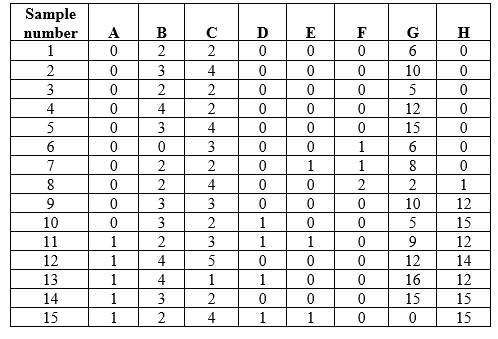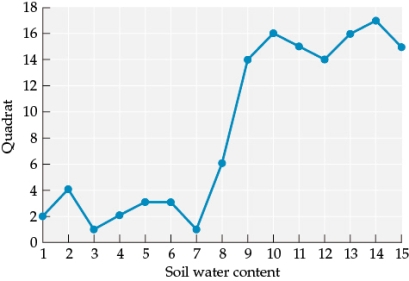Refer to the table and the figure.
Table 1
 Figure 2
Figure 2
 Suppose you are researching an ecological community in a new study area. You divide your study area into quadrats and sample one quadrat a day to determine the species that occupy the area and how many individuals of these species are present. Assume that by the end of your sampling efforts, you have identified all of the species that occur in the study area. Suppose that in addition to finding individuals and identifying species, you also collect information on abiotic factors and environmental conditions in the study area. Figure 2 shows how abiotic factors vary across the quadrats sampled. Based on your samples of the numbers of individuals of each species that occur in these quadrats (Table 1), which species is most affected by quadrat-level differences in soil water content? Based on both Table 1 and Figure 2, how would you define communities and determine the number of communities in your study area? How might this information influence how you categorize your quadrats into communities?
Suppose you are researching an ecological community in a new study area. You divide your study area into quadrats and sample one quadrat a day to determine the species that occupy the area and how many individuals of these species are present. Assume that by the end of your sampling efforts, you have identified all of the species that occur in the study area. Suppose that in addition to finding individuals and identifying species, you also collect information on abiotic factors and environmental conditions in the study area. Figure 2 shows how abiotic factors vary across the quadrats sampled. Based on your samples of the numbers of individuals of each species that occur in these quadrats (Table 1), which species is most affected by quadrat-level differences in soil water content? Based on both Table 1 and Figure 2, how would you define communities and determine the number of communities in your study area? How might this information influence how you categorize your quadrats into communities?
Definitions:
Open-loop Mode
A control system mode where the output is not fed back to the input for decision making, meaning actions are taken without considering the outcome.
Feedback
In analog systems, a correcting signal received from the output or an output monitor. The correcting signal is fed to the controller for process correction.
Tachometer
An instrument used to measure the rotation speed of a shaft or disk, displayed in revolutions per minute (RPM).
Speed Measurement
The process of determining the rate of movement of an object, typically measured in units like meters per second or miles per hour.
Q6: Refer to the tables.<br> <img src="https://d2lvgg3v3hfg70.cloudfront.net/TBO1115/.jpg" alt="Refer
Q26: Which statement describes the most likely reason
Q27: Use inequalities generated by the Lotka-Volterra
Q28: Which of the following is not an
Q33: Consider two tropical forests, each of which
Q36: Refer to the table.<br><img src="https://d2lvgg3v3hfg70.cloudfront.net/TBO1115/.jpg" alt="Refer to
Q42: Refer to the table.<br><img src="https://d2lvgg3v3hfg70.cloudfront.net/TBO1115/.jpg" alt="Refer to
Q55: Which specific hypothesis is best supported by
Q56: Farrell's studies of algal succession on the
Q69: Species A is a nonreproductive shrub